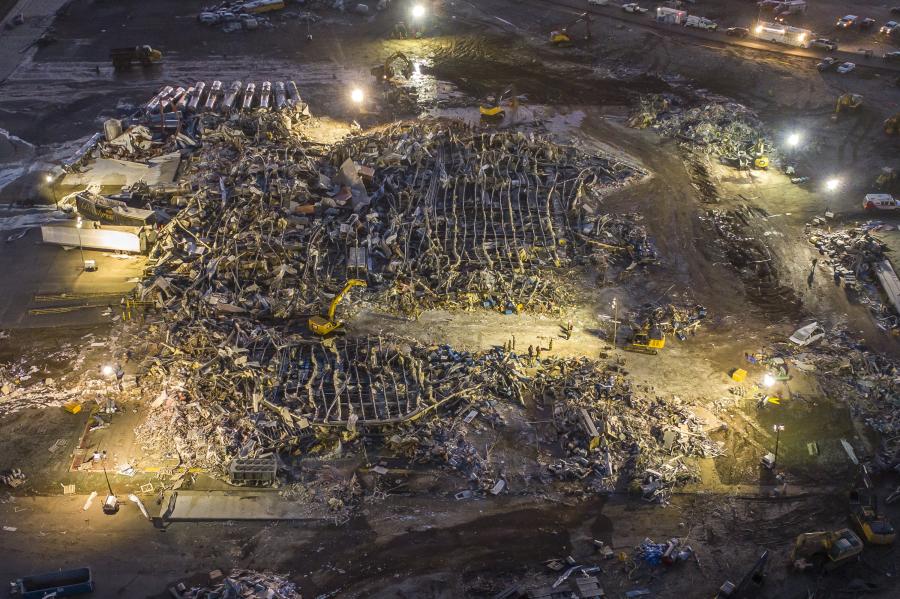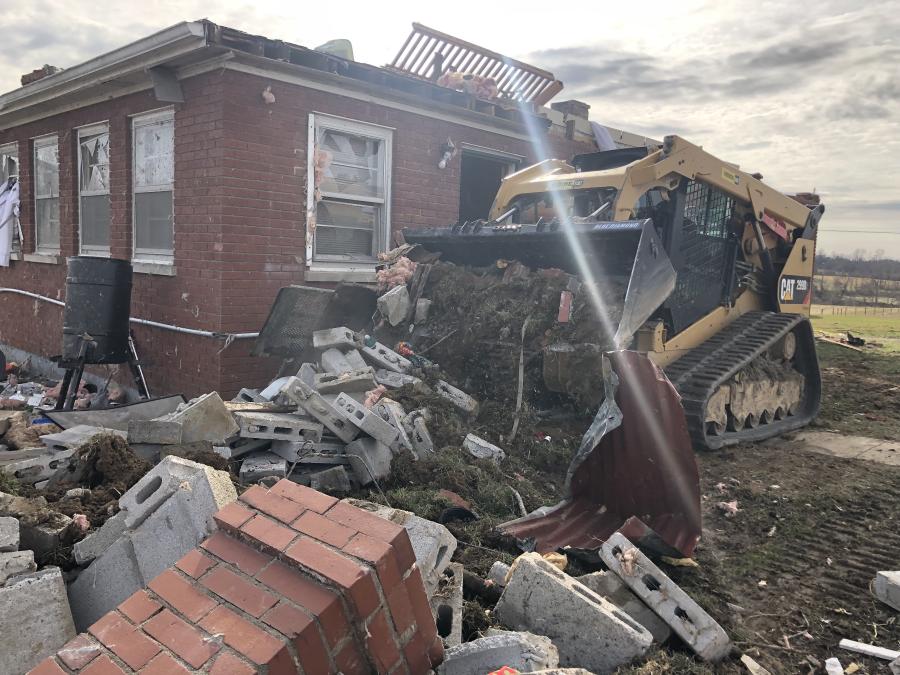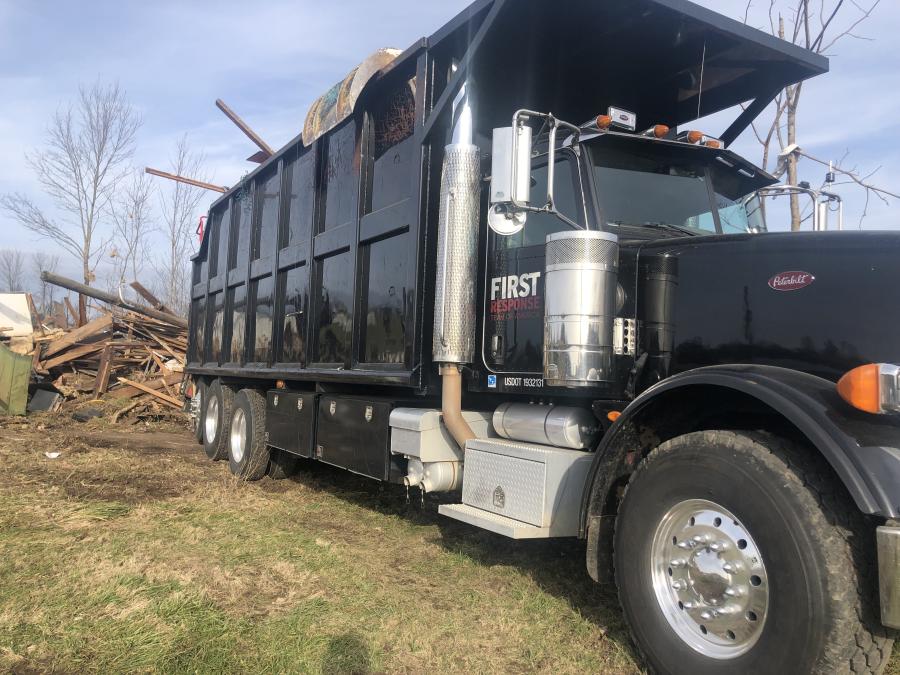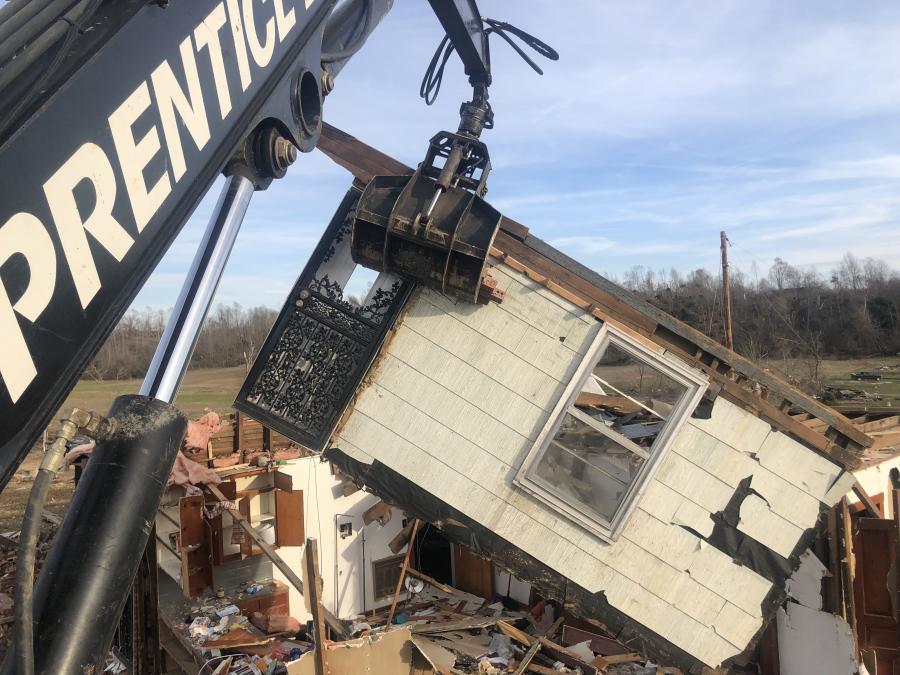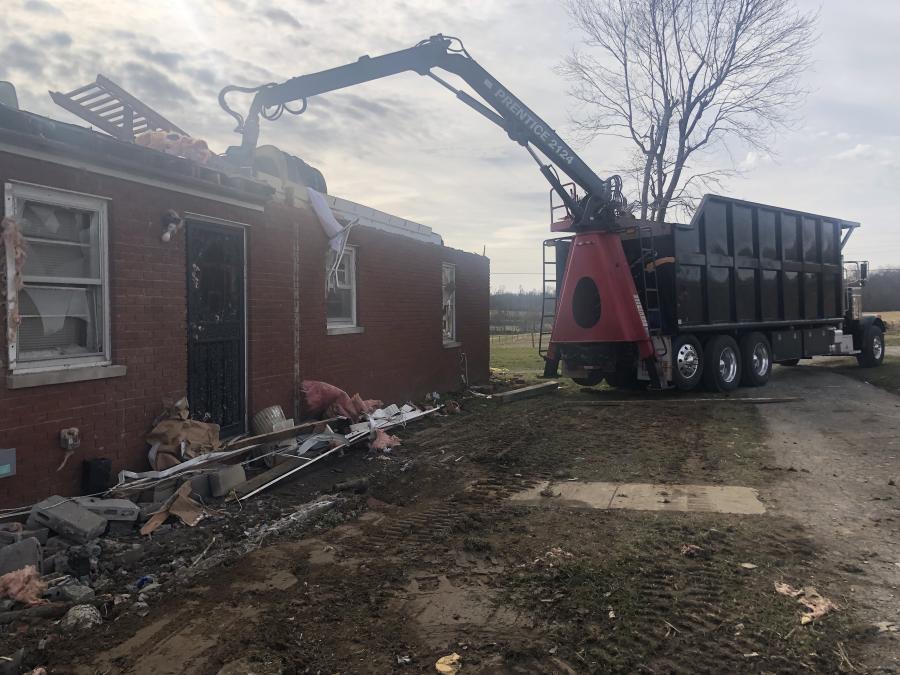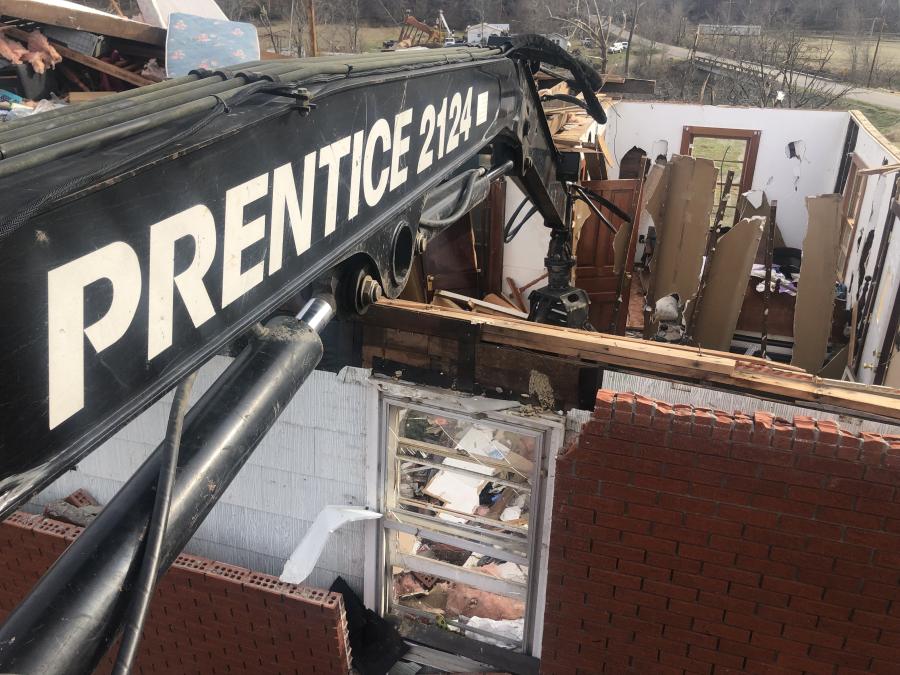Excavators, large and compact loaders and haul trucks, as well as generators and light towers, have been just a few of the pieces brought to communities in the eight states unfortunate enough to be in the path of the unprecedented December twisters.
(AP photo)
The versatility and durability of machines built for heavy construction has had high visibility outside the industry since the day after a rare and powerful tornado outbreak slammed through the Midwest, Mississippi Valley and South in the overnight hours of Dec. 10-11.
Whenever major disasters strike, recovery teams rely on a variety of heavy equipment to pick up and clear away debris. First responders also bring an array of lighter pieces and tools, found on any building site, to conduct search and rescue operations and break wreckage into manageable pieces.
Excavators, large and compact loaders and haul trucks, as well as generators and light towers, have been just a few of the pieces brought to communities in the eight states unfortunate enough to be in the path of the unprecedented December twisters.
Dozens of tornadoes are confirmed to have touched down in many towns and rural areas of Arkansas, Missouri, Kentucky, Illinois, Mississippi, Tennessee, Ohio and Georgia.
When daylight broke on Dec. 11, officials in the affected areas were stunned to see the level of ruin and death left behind by the violent storms.
One week later, officials announced that 93 people had lost their lives from the weather system, 78 of them in Kentucky, a state that saw multiple tornadoes and suffered billions of dollars in damage.
A mixture of federal response teams, led by the Department of Homeland Security and the Federal Emergency Management Agency (FEMA), along with state agencies, national guard battalions and municipalities, were quickly dispatched to the affected areas. In addition, long-established charitable organizations like the American Red Cross, which specialize in tending to victims of natural disasters, also reacted promptly.
Not to be overlooked, though is that events like these also draw the attention of smaller volunteer groups that have built trusted reputations in lending an expert hand in recovery and cleanup efforts. They often play a pivotal role on the micro level in helping families and individuals more quickly than larger organizations.
Nonprofit Noted for Recovery Expertise
One of the more recognized and highly praised is First Response Team of America, a nonprofit storm recovery operation located in Lancaster, Pa. It is known for effectively responding to the scene of many catastrophes across the United States, including hurricanes, floods, ice storms, wildfires and earthquakes.
Tad Agoglia founded the company in 2007 after previously owning a construction company that used excavators, compact track loaders, haul trucks and crane trucks.
Although quite modest in comparison to groups like the Red Cross, First Response Team is both mighty and well known, due to its personable leader.
Agoglia and his crew have been profiled by news networks and national publications, and over the last 14 years has established solid, working relationships with large and small equipment manufacturers to obtain the machines, trucks, trailers and tools First Response Team has needed to help victims of tragedies.
Often, the team works at disaster scenes with just a few people making up a crew, but Agoglia noted he has had as many as 60 to 70 folks volunteer with First Response Team in one day.
Major manufacturers like Caterpillar, Peterbilt, Prentice, Allmand, Ledwell and Lincoln Electric, among others, have come to understand the value of Agoglia's volunteer efforts and either donated or lent him, through their dealer networks, the equipment he requires to clear storm debris from roads and properties.
First Response Team, in turn, uses the machinery to assist victims that often lack the resources to pay for the service.
But Agoglia finds it more important that he and his team of experts can go where they determine their assistance is most needed and perform heavy work that often lasts many long and laborious hours.
"So long as the people are there and at their homesites, we want to be able to help them," he said.
Choosing the Right Equipment Is Critical
After hearing reports of the tornado outbreak, Agoglia and his small team immediately began packing to make the long drive to Kentucky to find places to lend a hand.
The key to working in catastrophic situations, he explained, is being experienced enough to match the proper equipment with the anticipated disaster scene.
For instance, they brought along a Peterbilt truck equipped with a Prentice-made grapple loader designed to hold 120-cu.-yds. of debris, he explained.
"We also have another Peterbilt sleeper cab that is hauling a Ledwell trailer carrying a Cat excavator and a 299 compact track loader, plus a mechanic truck for fuel," he said. "We also have Cat generators, a Lincoln Electric welding generator, Allmand light towers and water pumps. It is quite a lineup of equipment and tools because you never know what you are going to need."
Chain saws and plasma cutters, Agoglia added, are also found in First Response's toolbox.
"I have been doing this since 2007 and I will tell you that sometimes people are not good at understanding what these machines can do," he said. "Residents often think we are part of a municipality with a backhoe, but they don't realize how specialized this equipment is for clearing disaster debris. This Peterbilt truck I use holds the equivalent of six full tandem-axle dump trucks in one, and it also loads itself. If you don't have equipment with the right attachments, like hydraulic grapples, this material is very difficult to handle because it is the opposite of dirt, which fills every crevice of a bucket. With just a backhoe, the debris will not conform to that bucket and the machine is hard to use for picking up and loading."
Rapport With Dealers Fuels First Response Team
Agoglia described his company and Cat dealers as enjoying a "special relationship," where, if his crew requires more equipment, the maker's local distributors make sure they are lent what they need free of charge.
"It is as simple as sending a text message to one of my contacts at Cat, Chris Gustafson, a division manager who is my liaison between Cat corporate and its dealers," said Agoglia, who has worked with Gustafson for several years. "By contacting Chris, I often will have tractor trailer loads of equipment begin to show up wherever we are working, and then they will tell me, ‘Hey, just let us know when you are finished, and we will come get them.'"
Gustafson also has helped Agoglia acquire other machinery, like the light towers and water pumps, by speaking to those manufacturers on his behalf.
"Here in Kentucky, I needed help from the local dealer, Boyd CAT, to find a place to park our equipment overnight, plus a loading dock to unload some machines from my tractor trailer," he said, "so yesterday I texted Chris to ask if he could connect me with the nearest Boyd CAT branch. Luckily, they have dealerships across the state and were happy to help."
In fact, from its base in Louisville, Boyd CAT maintains 19 locations, mostly in Kentucky, but also in southern Indiana, West Virginia and southeastern Ohio.
The Peterbilt trucks First Response Team has on hand is also due to its close bond with a dealer. John Arscott, the owner of The Pete Store in Baltimore, one of the largest Peterbilt distributorships on the East Coast, routinely helps Agoglia by making machine donations.
"He has become such a good friend," Agoglia said. "I initially went to him to buy a truck and, instead, he just gave me one right on the spot. Since then, John has donated five or six trucks to us. That is why we can do a lot of this work for free."
Scenes of Destruction Leave Agoglia Heartbroken
Much of First Response Team's work was around Campbellsville, Ky., in Taylor County, about 85 mi. south of Louisville. One person died there, and more than 70 homes were destroyed during the storm.
Upon reaching the county, the initial three-man crew found many wreckage-strewn properties and desperate homeowners in dire need of the volunteer group's assistance. He described the heartbreak they felt in witnessing exhausted residents frantically picking through the rubble of their homes looking for missing pets or prized possessions.
"It is almost always depressing because there is so much sadness and so much loss," he said. "I really feel the role we play … we're not here to fix anything; we're not here to be heroes; and we cannot bring someone back to life, but what we can do is play a small role in encouraging someone. If they are digging through their home's wreckage, and they believe a photo album is underneath their crushed car or a cat is trapped under a collapsed wall, those are things we can help with. It is simple, but it is what we can do as equipment operators and truck drivers."
Although each disaster is different, Agoglia and his team always begin their recovery efforts by talking to people and asking them what they need. Some have the resources to hire a contractor to remove a roof from their flattened house, but often First Response Team comes across folks with no insurance who try to handle the heavy work themselves, sometimes without the right tools at their disposal.
"For example, I cannot tell you how many times I have seen someone using a small Sawzall to try and remove a 60-ft. tree off their house," he said.
"The point is that is what we look for. So, in these types of storms, time really is of the essence because people are trying hard to get to their belongings before the next rain falls and ruins what they have left," Agoglia said. "They cannot lift walls to find clothes themselves, and as equipment operators, we sometimes lose sight of how unique our skills are to these people. To me, the equipment also plays a special role and without it, we would not be able to do this work." CEG
Eric Olson
A writer and contributing editor for CEG since 2008, Eric Olson has worked in the news-gathering business for 45 years.
Olson grew up in the small town of Lenoir, N.C. in the foothills of the Blue Ridge Mountains, where he began covering sports for the local newspaper at age 18. He continued to do that for several other dailies in the area while in college at Appalachian State University. Following his graduation, he worked for, among other companies, the Winston-Salem Journal, where he wrote and edited the newspaper's real estate and special features sections for 10 years. Since 1999 he has worked as a corporate media liaison and freelance writer, in addition to his time at CEG.
He and his wife, Tara, have been happily married for almost 40 years and are the parents of two grown and successful daughters. He currently is in the employ of two dogs and three cats, a job that he dearly loves.
Read more from Eric Olson here.
Today's top stories



